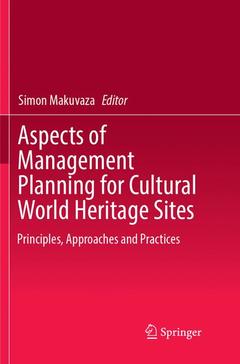Description
Aspects of Management Planning for Cultural World Heritage Sites, Softcover reprint of the original 1st ed. 2018
Principles, Approaches and Practices
Coordinator: Makuvaza Simon
Language: English
Keywords
preservation of single monuments to wide-ranging sites; evolution of the management of World Heritage properties; active engagement of communities living in and around sites; archaeological sites affected by looting and trafficking; heritage sites and the construction of cultural identities
Publication date: 09-2018
Support: Print on demand
Publication date: 12-2017
Support: Print on demand
Description
/li>Contents
/li>Biography
/li>Comment
/li>
Every site that is inscribed on the World Heritage List (WHL) must have a management plan or some other management system. According to the UNESCO Operational Guidelines, the purpose of a management plan is to ensure the effective protection of the nominated property for present and future generations. This requirement was in part necessitated by the need to implement real systems of monitoring on the management of World Heritage Sites.
Since its implementation in 2005, discussion on the function and the contents of management plans for World Heritage Sites has grown tremendously. The discussions have mainly been focused on the theoretical frameworks of World Heritage site management plans and proposals of practical guidelines for their implementation.
This volume provides a platform for heritage practitioners, especially those working at Cultural World Heritage Sites, to put in writing their experiences and impressions about the implementation of site management plans at properties that are inscribed on the WHL. Cultural World Heritage Sites in this case refer to world heritage properties such as archaeological sites, cultural landscapes, religious sites and architectural structures. The book also seeks to examine the extent to which site management plans have been or are being implemented at Cultural World Heritage Sites.
Reviews links and synergies with other legal instruments such as the UNESCO Recommendation on International Principles Applicable to Archaeological Excavations and the Convention on the Means of Prohibiting and Preventing the Illicit Import, Export and Transfer of Ownership of Cultural Property
Highlights implementation and effectiveness of such participation strategies with regard to the management of World Heritage Sites
Archaeological World Heritage sites offer invaluable information on the past of humankind for present and future generations, thereby contributing to long-term sustainable development in line with the recently adopted World Heritage Sustainable Development Policy




